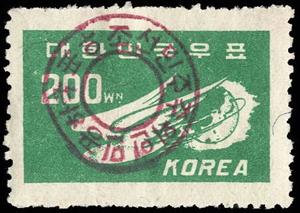Stamp: Bird and Globe (Korea, South- North Korean Occupation 1950)
Bird and Globe (Korea, South- North Korean Occupation 1950)
01 January (Korea, South- North Korean Occupation ) within release Occupation overprints goes into circulation Stamp Bird and Globe face value 200 Korean won
| Stamp Bird and Globe in catalogues | |
|---|---|
| Michel: | Mi: KP-KR 6 |
Stamp is horizontal format.
The authenticity of this stamp is doubtedAlso in the issue Occupation overprints:
- Stamp - Admiral Li Sun-sin face value 500;
- Stamp - Bird and Globe face value 200;
- Stamp - Diamond Mountains face value 20;
- Stamp - Diamond Mountains face value 400;
- Stamp - Four-motor Plane and globe face value 150;
- Stamp - Ginseng Plant face value 30;
- Stamp - Red-crowned Crane (Grus japonensis) face value 10;
- Stamp - South Gate, Seoul face value 50;
- Stamp - Tabo Pagoda, Kyongju face value 100;
Stamp Bird and Globe it reflects the thematic directions:
Birds (Aves), a subgroup of Reptiles, are the last living examples of Dinosaurs. They are a group of endothermic vertebrates, characterised by feathers, toothless beaked jaws, the laying of hard-shelled eggs, a high metabolic rate, a four-chambered heart, and a strong yet lightweight skeleton. Birds live worldwide and range in size from the 5 cm (2 in) bee hummingbird to the 2.75 m (9 ft) ostrich. They rank as the class of tetrapods with the most living species, at approximately ten thousand, with more than half of these being passerines, sometimes known as perching birds. Birds are the closest living relatives of crocodilians.
A globe is a spherical model of Earth, of some other celestial body, or of the celestial sphere. Globes serve purposes similar to maps, but, unlike maps, they do not distort the surface that they portray except to scale it down. A model globe of Earth is called a terrestrial globe. A model globe of the celestial sphere is called a celestial globe


